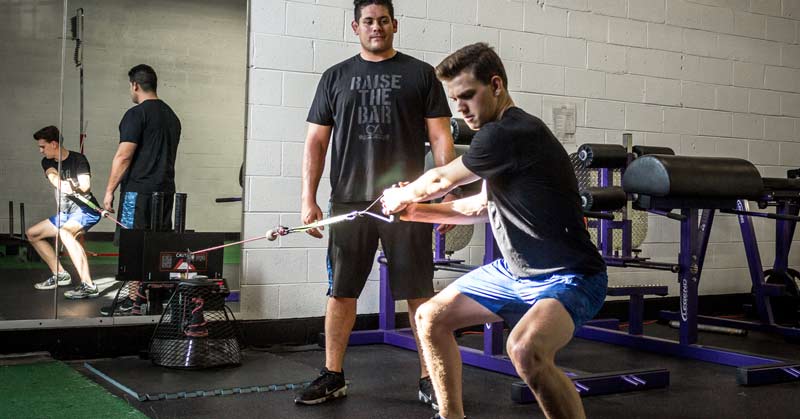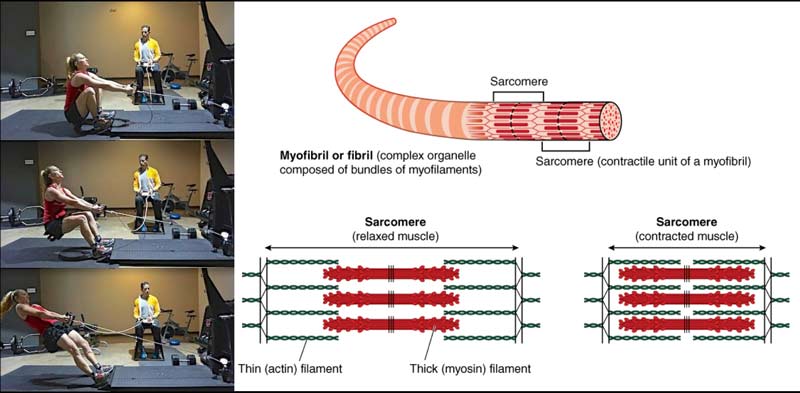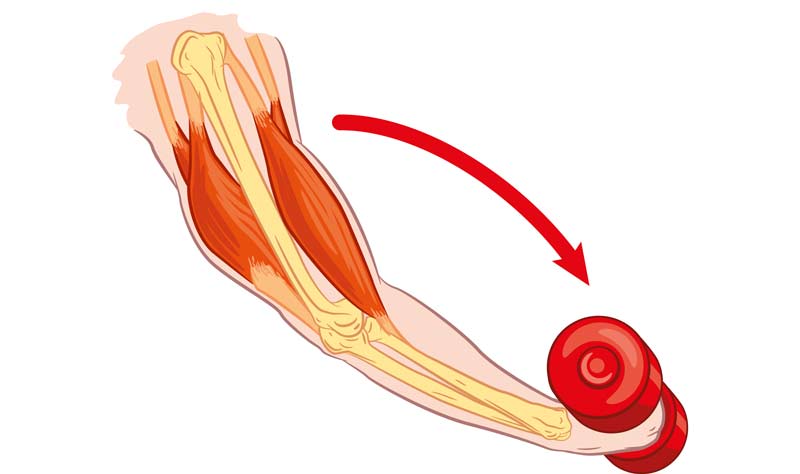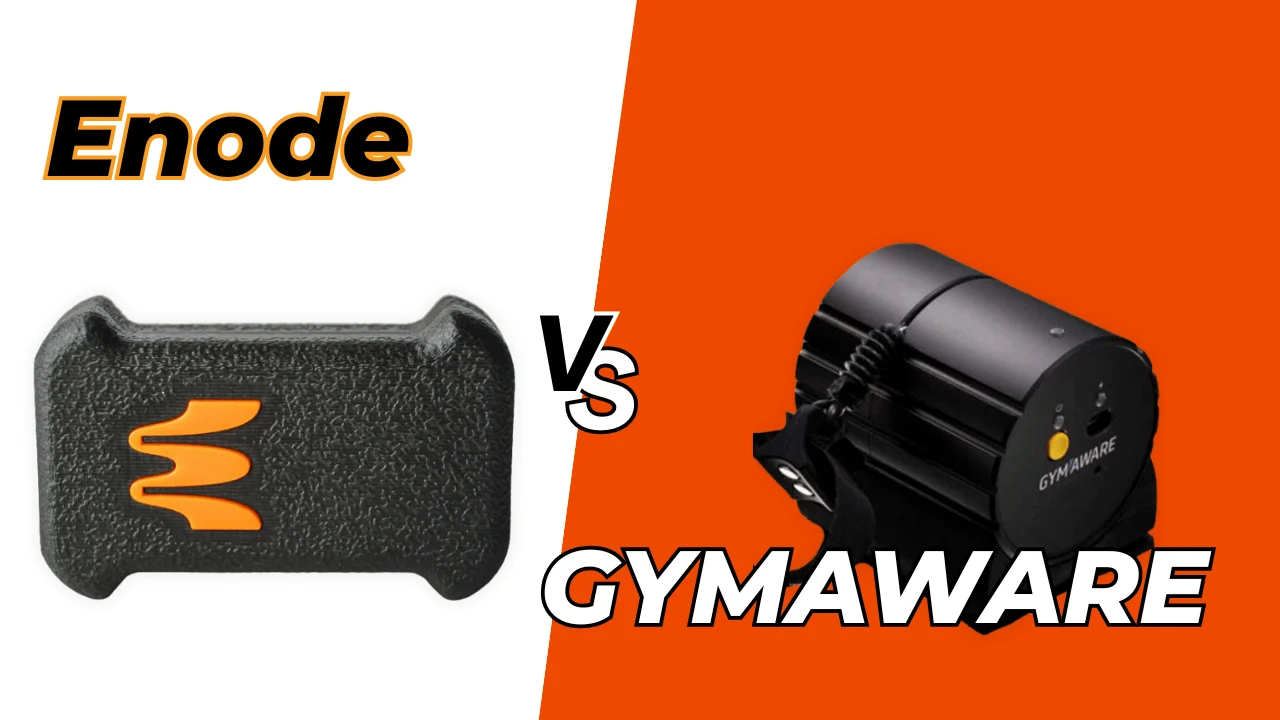[mashshare]

By Jennifer Reiner-Marcello, Brandon Marcello
In the world of rehabilitation and training, eccentric exercises are imperative for developing strength, power, and resilience (Alfredson, 2003; Gonzalo-Skok et al., 2016; LaStayo et al., 2003; Roig, Shadgan, & Reid, 2008). Traditionally, eccentric movements are trained using barbells, dumbbells, tubing, chains, and plyometric exercises. The presence of flywheel technology (e.g., VersaPulley™, kBox, Desmotec, Proinertial) for training spans several decades in both the rehabilitation and performance community. However, not until recently has this form of inertia-based training received more attention from the collegiate, private, and professional training centers.
Perhaps this new-found interest is due to the simplicity of training multidirectional movements in the horizontal and vertical planes in an eccentrically overloaded environment. This is possibly the most effective way for increasing muscle strength (Brandenburg & Docherty, 2002; Hedayatpour & Falla, 2015; Hortobagyi, Barrier, & Beard, 1996; Hortobagyi et al., 1996; Hortobagyi, Devita, Money, & Barrier, 2001; B. Johnson, 1972) in a shorter period of time when compared to more traditional 1:1 (concentric:eccentric) exercise training(English, Loehr, Lee, & Smith, 2014).
It’s this eccentric overload applied in a task-specific environment that captures the next level of improved performance otherwise unattainable through traditional training methods.
Flywheel Training: A Long History in Science and Practice
Research on flywheel devices dates back to the early 1900’s by Krogh 1913, Hill 1920, and Hansen and Lindhard in 1923 (Hansen & Lindhard, 1923; Hill, 1920; Krogh, 1913), but the use of flywheels for performance became popular in the late 1980s and early 1990s when NASA began examining ways to maintain lean muscle mass and bone density during extended travel in the zero-gravity atmosphere of space (Dudley, Tesch, Miller, & Buchanan, 1991). Since then, numerous studies have been published demonstrating the effectiveness of flywheel training for developing strength, hypertrophy, power, injury prevention, and rehabilitation (Alfredson, 2003; Gonzalo-Skok et al., 2016; LaStayo et al., 2003; Roig et al., 2008).

The benefits of inertial based training are rooted in the extensive research surrounding eccentric training. Beginning at the cellular level, forces imparted to tendons and muscles are converted from mechanical stimuli into biochemical signals. This is referred to as mechanotransduction (Maffulli & Longo, 2008), which in turn results in remodeling of the myofilaments and adaptation of the viscoelastic properties of the muscle (Yu, Furst, & Thornell, 2003).
Research shows these other benefits also occur:
- recruitment of slow-contraction motor units
- activation of a large number of motor units (neural adaptation)
- increased dynamic and passive muscular endurance (mechanical adaptation)
- longitudinal addition of sarcomeres
- adaptation to the inflammatory response
- adaptation to maintain muscle excitation-contraction coupling (cellular adaptation) (McHugh, 2003; Miyama & Nosaka, 2007).
These positive cellular, mechanical, and neural adaptations are the result of the repeated bout effect (RBE). Consequently, there is an increased “stiffness” of the muscle-tendon unit (Lindstedt, LaStayo, & Reich, 2001) that makes the tissue more resilient and able to handle higher loads or forces imparted into the structure.
While it would seem that an increase in passive muscle stiffness would limit joint range of motion, evidence leads us to believe the contrary. In fact, according to a systematic review by O’Sullivan in 2012, long-term eccentric training revealed improved flexibility (O’Sullivan, McAuliffe, & Deburca, 2012). This improvement is attributed to an increase in the number of sarcomeres distributed in series, also known as sarcomerogenesis (Butterfield, Leonard, & Herzog, 2005; Lynn, Talbot, & Morgan, 1998; Yu et al., 2003).
It’s proposed that sarcomerogenesis, along with adaptations to the passive elements within the muscle, create a shift in the muscle length-tension curve that consistently occurs with eccentric training (O’Sullivan et al., 2012). The resulting benefit includes greater motor control throughout a larger range of motion ultimately leading to improved performance and protection against injury.
Building High Total Body Resilience with Eccentric Overload
Eccentric training’s protective benefits have direct implications in rehabilitation and reconditioning. Because forces are extremely high during the eccentric, or lengthening phase, of movement, injuries often occur during the deceleration (LaStayo et al., 2003) of the body. If the forces needed for deceleration exceed those of the muscle-tendon system, injury to the muscle, myotendinous unit, the tendon itself, and the osteotendinous insertion may occur (LaStayo et al., 2003).
Research suggests that athletes with a history of recurring hamstring and adductor muscle strains possess greater impairment of their eccentric strength (2-fold) as compared to concentric strength, suggesting that improvement in the former may minimize the risk of injury (LaStayo et al., 2003). At the knee, the hamstring’s eccentric activity provides a posterior pull on the tibia to offset the anterior force of the quadriceps (Shimokochi & Shultz, 2008).
Along with their role in knee stabilization, the hamstrings are eccentrically activated before initial limb contact in movements such as cutting, stopping, and landing maneuvers (Nyland, Shapiro, Caborn, Nitz, & Malone, 1997). This “presetting” of the hamstrings along with eccentric quadriceps activity during the loading phase is crucial for proper shock absorption and protection against knee injuries such as ACL tears.
Similarly, training eccentrically for deceleration forces encountered in the upper extremity is pertinent for rehabilitation and injury prevention of the overhead athlete. The distraction forces from throwing a baseball at the glenohumeral joint are equal to one to one and a half times body weight (Fleisig, Andrews, Dillman, & Escamilla, 1995). For this reason, muscles in the shoulder must undergo high decelerative eccentric contractions to preserve healthy joint arthrokinematics (Ellenbecker, Davies, & Rowinski, 1988). Whether used along the rehabilitation continuum or as part of a training program, eccentric and eccentric overload training are critical to preparing the athlete for the forces they will encounter during practice or competition.
Eccentric Overload: Performance
As we turn our focus to performance, we must ask what the benefits are to strength, power, hypertrophy, and injury prevention when adding eccentric overload training. What does the science indicate? The higher forces generated (2-3 times greater than those produced either isometrically or concentrically) (Johnson, 1972; Jones & Rutherford, 1987) through eccentric training have shown it to be a superior method in developing both strength and hypertrophy (Hollander et al., 2007).
#EccentricOverload is a superior method to develop strength and hypertrophy. Share on XBecause it’s more effective than concentric training at increasing total and eccentric strength (Roig et al., 2009), it should be used to enhance the effects of the typical training seen in most weight rooms around the world. Studies have also shown that eccentric overload training is superior to eccentric underload in its ability to stimulate increases in strength (English et al., 2014), but even more significant is the speed in which training adaptations take place. When compared to traditional concentric/eccentric training, eccentric overload was the only training regimen to increase lower body lean muscle mass and show improvement in bone mineral density after only eight weeks of similar training (English et al., 2014).
Eccentric Overload Training: Hypertrophy
Further studies examining eccentric overload training and its effects on muscle hypertrophy showed similar effects (de Souza-Teixeira & de Paz, 2012; Hedayatpour & Falla, 2015; Mayhew, Rothstein, Finucane, & Lamb, 1995; Ojasto & Hakkinen, 2009; Tesch, Ekberg, Lindquist, & Trieschmann, 2004; Vikne et al., 2006; Walker et al., 2016).
Greater hypertrophy was also reported following chronic resistance training comprised of coupled eccentric and concentric actions or eccentric actions compared with concentric actions only (Hather, Tesch, Buchanan, & Dudley, 1991; Higbie, Cureton, Warren, & Prior, 1996; Hortobagyi et al., 1995; Norrbrand, Pozzo, & Tesch, 2010) This is another reason why using eccentric overload training in conjunction with traditional weight training should be heavily considered.
Put simply, greater muscle hypertrophy is a result of enhanced muscle protein synthesis, which is a product of higher mechanical loading of the muscle. This type of mechanical loading is created by eccentric muscle actions (Norrbrand et al., 2010).

From the vantage points of power development and application of force, higher muscle forces can be produced during eccentric contractions compared with concentric (Roig et al., 2009). And while all types of training can improve power in multiple planes of movement, the specificity of training adaptation principle mainly prevails (Gonzalo-Skok et al., 2016).
One particular study examined this specificity by programming exercises in both the vertical and horizontal planes. The results were what one would likely expect. Those who trained vertically improved in all planes, but made the most gains vertically (vertical jump) and those who trained multi-directionally also improved across the board but gained the most multi-directionally (acceleration and change of direction) (Gonzalo-Skok et al., 2016).
Research from 2016 indicated that those who train using eccentric overload were able to produce a significantly greater breaking and propulsive contact time (de Hoyo et al., 2016). This suggests that eccentric overload could be a fundamentally important mechanism underpinning change of direction ability (de Hoyo et al., 2016).
In short, neuromuscular and functional changes induced by exercise are specific to the mode of exercise performed (Hedayatpour & Falla, 2015). Therefore, by not performing exercises that encompass eccentric overload as a stimulus, an entire cascade of neural, physiological, and muscular adaptations will be neglected and underdeveloped. While all of these methods are important to the training, rehabilitation, and reconditioning of athletes, they offer mostly constant concentric and eccentric load in exercises emphasizing vertical actions.
In most sports, athletes are required to repeatedly perform short explosive efforts such as accelerations and decelerations during changes of direction (de Hoyo et al., 2015). The capacity to dissipate the forces during abrupt deceleration (breaking ability) is critical to injury prevention, while the ability to decelerate and reaccelerate in a short period of time (reactive strength) is paramount to enhanced performance.
Whether one is training to improve strength, power, or change of direction, rehabilitating from an injury, or improving resilience, the flywheel designed by VersaPulley™ is a safe and effective tool for training at any load, at any speed, and in any plane within an infinite amount of exercise variation. Because of its high/low capabilities, the VersaPulley™ allows for the prescription of exercises in all planes of motion, creating training stimuli from the general to the specific.
Implementation of eccentric overload strength training has been lacking in traditional strength and conditioning program designs (Hollander et al., 2007). In short, if programmed and implemented correctly, eccentric overload training should be an integral part of any comprehensive rehabilitation or training program seeking to improve performance and decrease injury potential.
Going Beyond Gravity with Flywheel Eccentric Training
In conclusion, traditional weight training using gravity-dependent tools leaves a gap in preparing an athlete to manage all aspects of performance. Barbells, dumbbells, kettlebells, and the like offer constant concentric and eccentric load in exercises emphasizing vertical action, yet they rarely encompass horizontal/lateral actions offering eccentric overload (Tous-Fajardo, Gonzalo-Skok, Arjol-Serrano, & Tesch, 2016). Furthermore, a person’s ability to complete an eccentric-isometric-concentric cycle under maximal load is limited by the force production in the concentric phase (Hortobagyi, Devita, Money, & Barrier, 2001).
This means that traditional weight training creates an ideal environment for concentric strength and eccentric underload. Even with the addition of tools such as bands and chains, an eccentric overload is not achieved, and attempting to do so in this setting would be unsafe and expose those training to an unnecessary risk of injury. While we have used a number of flywheel devices, we have the most familiarity with the VersaPulley™ which was designed to create those moments of eccentric overload, allowing the athlete to be exposed to these stresses in a non-impact, concentrically-driven, and eccentrically overloaded environment. The flywheel device picks up where traditional gravity-based weights, chains, bands, and air-powered machines stop.
Since you’re here…
…we have a small favor to ask. More people are reading SimpliFaster than ever, and each week we bring you compelling content from coaches, sport scientists, and physiotherapists who are devoted to building better athletes. Please take a moment to share the articles on social media, engage the authors with questions and comments below, and link to articles when appropriate if you have a blog or participate on forums of related topics. — SF
[mashshare]
References
- Alfredson, H. (2003). Chronic midportion achilles tendinopathy: An update on research and treatment. Clinics in Sports Medicine, 22(4), 727-741.
- Brandenburg, J. P., & Docherty, D. (2002). The effects of accentuated eccentric loading on strength, muscle hypertrophy, and neural adaptations in trained individuals. Journal of Strength and Conditioning Research, 16(1), 25-32.
- Butterfield, T. A., Leonard, T. R., & Herzog, W. (2005). Differential serial sarcomere number adaptations in knee extensor muscles of rats is contraction type dependent. Journal of Applied Physiology (Bethesda, Md.: 1985), 99(4), 1352-1358. doi:00481.2005 [pii]
- de Hoyo, M., Sanudo, B., Carrasco, L., Mateo-Cortes, J., Dominguez-Cobo, S., Fernandes, O.,… Gonzalo-Skok, O. (2016). Effects of 10-week eccentric overload training on kinetic parameters during change of direction in football players. Journal of Sports Sciences, 34(14), 1380-1387. doi:10.1080/02640414.2016.1157624 [doi]
- de Hoyo, M., de la Torre, A., Pradas, F., Sanudo, B., Carrasco, L., Mateo-Cortes, J.,… Gonzalo-Skok, O. (2015). Effects of eccentric overload bout on change of direction and performance in soccer players. International Journal of Sports Medicine, 36(4), 308-314. doi:10.1055/s-0034-1395521 [doi]
- de Souza-Teixeira, F., & de Paz, J. A. (2012). Eccentric resistance training and muscle hypertrophy. Sports Medicine and Doping Studies, S1(004)
- Dudley, G. A., Tesch, P. A., Miller, B. J., & Buchanan, P. (1991). Importance of eccentric actions in performance adaptations to resistance training. Aviation, Space, and Environmental Medicine, 62(6), 543-550.
- Ellenbecker, T. S., Davies, G. J., & Rowinski, M. J. (1988). Concentric versus eccentric isokinetic strengthening of the rotator cuff: objective data versus functional test. The American Journal of Sports Medicine, 16(1), 64-69.
- English, K. L., Loehr, J. A., Lee, S. M., & Smith, S. M. (2014). Early-phase musculoskeletal adaptations to different levels of eccentric resistance after 8 weeks of lower body training. European Journal of Applied Physiology, 114(11), 2263-2280. doi:10.1007/s00421-014-2951-5 [doi]
- Fleisig, G. S., Andrews, J. R., Dillman, C. J., & Escamilla, R. F. (1995). Kinetics of baseball pitching with implications about injury mechanisms. The American Journal of Sports Medicine, 23(2), 233-239.
- Gonzalo-Skok, O., Tous-Fajardo, J., Valero-Campo, C., Berzosa, C., Bataller, A. V., Arjol-Serrano, J. L.,… Mendez-Villanueva, A. (2016). Eccentric overload training in team-sports functional performance: Constant bilateral vertical vs. variable unilateral multidirectional movements. International Journal of Sports Physiology and Performance, 1-23. doi:10.1123/ijspp.2016-0251 [doi]
- Hansen, T. E., & Lindhard, J. (1923). On the maximum work of human muscles especially the flexors of the elbow. The Journal of Physiology, 57(5), 287-300
- Hather, B. M., Tesch, P. A., Buchanan, P., & Dudley, G. A. (1991). Influence of eccentric actions on skeletal muscle adaptations to resistance training. Acta Physiologica Scandinavica, 143(2), 177-185. doi:10.1111/j.1748-1716.1991.tb09219.x [doi]
- Hedayatpour, N., & Falla, D. (2015). Physiological and neural adaptations to eccentric exercise: Mechanisms and considerations for training. BioMed Research International, 2015, 193741. doi:10.1155/2015/193741 [doi]
- Higbie, E. J., Cureton, K. J., Warren, G. L.,3rd, & Prior, B. M. (1996). Effects of concentric and eccentric training on muscle strength, cross-sectional area, and neural activation. Journal of Applied Physiology (Bethesda, Md.: 1985), 81(5), 2173-2181.
- Hill, A. V. (1920). An instrument for recording the maximum working a muscular contraction. Journal of Physiology, 53, 138-143.
- Hollander, D. B., Kraemer, R. R., Kilpatrick, M. W., Ramadan, Z. G., Reeves, G. V., Francois, M.,… Tryniecki, J. L. (2007). Maximal eccentric and concentric strength discrepancies between young men and women for dynamic resistance exercise. Journal of Strength and Conditioning Research / National Strength & Conditioning Association, 21(1), 34-40. doi:R-18725 [pii]
- Hortobagyi, T., Barrier, J., & Beard, D. (1996). Greater initial adaptations to submaximal muscle lengthening than maximal shortening. Journal of Applied Physiology (Bethesda, Md.: 1985), 81, 1677-1682.
- Hortobagyi, T., Devita, P., Money, J., & Barrier, J. (2001). Effects of standard and eccentric overload strength training in young women. Medicine and Science in Sports and Exercise, 33(7), 1206-1212.
- Hortobagyi, T., Hill, J. P., Houmard, J. A., Fraser, D. D., Lambert, N. J., & Israel, R. G. (1996). Adaptive responses to muscle lengthening and shortening in humans. Journal of Applied Physiology (Bethesda, Md.: 1985), 80(3), 765-772.
- Hortobagyi, T., Zheng, D., Weidner, M., Lambert, N. J., Westbrook, S., & Houmard, J. A. (1995). The influence of aging on muscle strength and muscle fiber characteristics with special reference to eccentric strength. The Journals of Gerontology.Series A, Biological Sciences and Medical Sciences, 50(6), B399-406.
- Johnson, B. (1972). Eccentric and concentric muscle training for strength development. Med.Sci.Sports, 4, 111
- Jones, D., & Rutherford, O. (1987). Human muscle strength training: The effects of three different regimens and the nature of the resultant changes. J. Physiol., (391), 111.
- Krogh, A. (1913). A bicycle ergometer and respiration apparatus for the experimental study of muscular Work1. Skandinavisches Archiv Für Physiologie, 30(3), 375-394. doi:10.1111/j.1748-1716.1913.tb00681.x
- LaStayo, P. C., Woolf, J. M., Lewek, M. D., Snyder-Mackler, L., Reich, T., & Lindstedt, S. L. (2003). Eccentric muscle contractions: Their contribution to injury, prevention, rehabilitation, and sport. The Journal of Orthopaedic and Sports Physical Therapy, 33(10), 557-571. doi:10.2519/jospt.2003.33.10.557 [doi]
- Lindstedt, S. L., LaStayo, P. C., & Reich, T. E. (2001). When active muscles lengthen: Properties and consequences of eccentric contractions. News in Physiological Sciences: An International Journal of Physiology Produced Jointly by the International Union of Physiological Sciences and the American Physiological Society, 16, 256-261.
- Lynn, R., Talbot, J. A., & Morgan, D. L. (1998). Differences in rat skeletal muscles after incline and decline running. Journal of Applied Physiology (Bethesda, Md.: 1985), 85(1), 98-104
- Maffulli, N., & Longo, U. G. (2008). How do eccentric exercises work in tendinopathy? Rheumatology, 47(10), 1444.
- Mayhew, T. P., Rothstein, J. M., Finucane, S. D., & Lamb, R. L. (1995). Muscular adaptation to concentric and eccentric exercise at equal power levels. Medicine and Science in Sports and Exercise, 27(6), 868-873.
- McHugh, M. P. (2003). Recent advances in the understanding of the repeated bout effect: The protective effect against muscle damage from a single bout of eccentric exercise. Scandinavian Journal of Medicine & Science in Sports, 13(2), 88-97. doi:2R477 [pii]
- Miyama, M., & Nosaka, K. (2007). Protection against muscle damage following fifty drop jumps conferred by ten drop jumps. Journal of Strength and Conditioning Research, 21(4), 1087-1092. doi:R-21056 [pii]
- Norrbrand, L., Pozzo, M., & Tesch, P. A. (2010). Flywheel resistance training calls for greater eccentric muscle activation than weight training. European Journal of Applied Physiology, 110(5), 997-1005. doi:10.1007/s00421-010-1575-7 [doi]
- Nyland, J., Shapiro, R., Caborn, D., Nitz, A., & Malone, T. (1997). The effect of quadriceps femoris, hamstring, and placebo eccentric fatigue on knee and ankle dynamics during crossover cutting. Journal of Orthopedics Sports Physical Therapy, 25, 171
- Ojasto, T., & Hakkinen, K. (2009). Effects of different accentuated eccentric loads on acute neuromuscular, growth hormone, and blood lactate responses during a hypertrophic protocol. Journal of Strength and Conditioning Research, 23(3), 946-953. doi:10.1519/JSC.0b013e3181a2b22f [doi]
- O’Sullivan, K., McAuliffe, S., & Deburca, N. (2012). The effects of eccentric training on lower limb flexibility: A systematic review. British Journal of Sports Medicine, 46(12), 838-845. doi:10.1136/bjsports-2011-090835 [doi]
- Roig, M., Shadgan, B., & Reid, W. D. (2008). Eccentric exercise in patients with chronic health conditions: A systematic review. Physiotherapy Canada.Physiotherapie Canada, 60(2), 146-160. doi:10.3138/physio.60.2.146 [doi]
- Roig, M., O’Brien, K., Kirk, G., Murray, R., McKinnon, P., Shadgan, B., & Reid, W. D. (2009b). The effects of eccentric versus concentric resistance training on muscle strength and mass in healthy adults: A systematic review with meta-analysis. British Journal of Sports Medicine, 43(8), 556-568. doi:10.1136/bjsm.2008.051417 [doi]
- Shimokochi, Y., & Shultz, S. J. (2008). Mechanisms of noncontact anterior cruciate ligament injury. Journal of Athletic Training, 43(4), 396-408. doi:10.4085/1062-6050-43.4.396 [doi]
- Tesch, P. A., Ekberg, A., Lindquist, D. M., & Trieschmann, J. T. (2004). Muscle hypertrophy following 5-week resistance training using a non-gravity-dependent exercise system. Acta Physiologica Scandinavica, 180(1), 89-98. doi:1225 [pii]
- Tous-Fajardo, J., Gonzalo-Skok, O., Arjol-Serrano, J. L., & Tesch, P. (2016). Enhancing change-of-direction speed in soccer players by functional inertial eccentric overload and vibration training. International Journal of Sports Physiology and Performance, 11(1), 66-73. doi:10.1123/ijspp.2015-0010 [doi]
- Vikne, H., Refsnes, P. E., Ekmark, M., Medbo, J. I., Gundersen, V., & Gundersen, K. (2006). Muscular performance after concentric and eccentric exercise in trained men. Medicine and Science in Sports and Exercise, 38(10), 1770-1781. doi:10.1249/01.mss.0000229568.17284.ab [doi]
- Walker, S., Blazevich, A. J., Haff, G. G., Tufano, J. J., Newton, R. U., & Hakkinen, K. (2016). Greater strength gains after training with accentuated eccentric than traditional isoinertial loads in already strength-trained men. Frontiers in Physiology, 7, 149. doi:10.3389/fphys.2016.00149 [doi]
- Yu, J. G., Furst, D. O., & Thornell, L. E. (2003). The mode of myofibril remodeling in human skeletal muscle affected by DOMS induced by eccentric contractions. Histochemistry and Cell Biology, 119(5), 383-393. doi:10.1007/s00418-003-0522-7 [doi]
 Dr. Jennifer Reiner-Marcello
Dr. Jennifer Reiner-Marcello
Dr. Jennifer Reiner-Marcello is a high-performance reconditioning and rehabilitation specialist, a chiropractic sports physician to a number of professional and Olympic athletes, and a consultant to health and fitness companies. Most recently, she served as a rehabilitation specialist for the San Diego Padres during the 2015-2016 MLB season.
Prior to her position with the Padres, Dr. Reiner-Marcello partnered with Water and Sports Physical Therapy to provide rehabilitation services at Fitness Quest 10, a sports performance facility in Scripps Ranch, California. She went on to open four additional locations, two of which were on the campus of Alexandria Center for Life Science where she was the director of chiropractic services for their corporate wellness center. In addition to her private practice, she served as the team chiropractor for the University of California San Diego from 2007-2013.
Dr. Reiner-Marcello continues to provide education on behalf of TRX as a sport medicine instructor. Additionally, she serves as an officer for Team Elite Cares, a non-profit organization providing rehabilitation, training, and education to youth athletes.
Dr. Reiner-Marcello received her bachelor’s degree in exercise and sports science from the University of Florida and her doctorate in chiropractic from Palmer College of Chiropractic West with a concentration in sports injury. She is a board Certified Chiropractic Sports Practitioner (CCSP), Certified Strength and Conditioning Specialist (CSCS) and holds additional certifications in the Functional Movement Screen (FMS), Selective Functional Movement Assessment (SFMA), Russian Kettlebell Certified (RKC), Graston Technique, Dynamic Neuromuscular Stabilization (DNS), Rock Tape, Functional Range Conditioning (FRC), running gait analysis, and is currently pursing her PRC from the Postural Restoration Institute (PRI).




